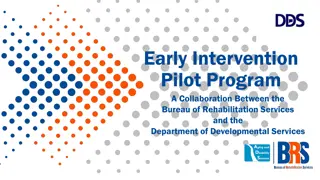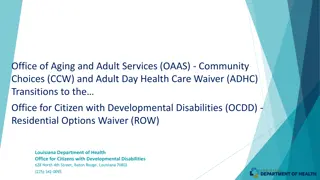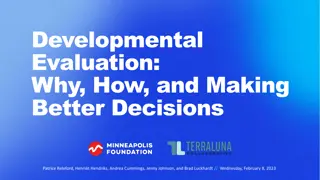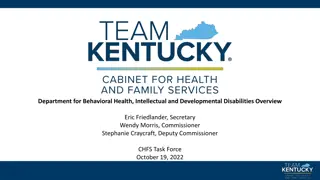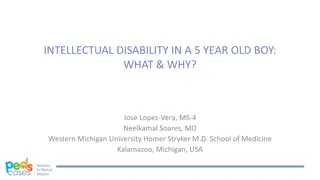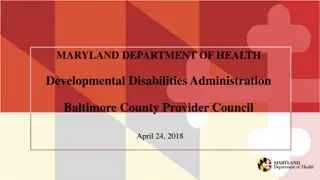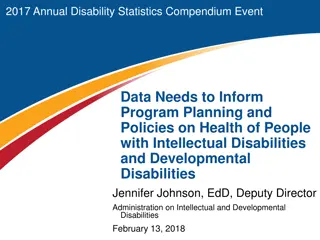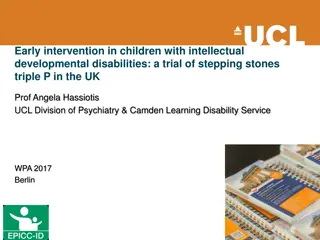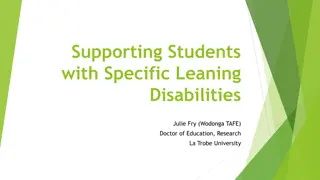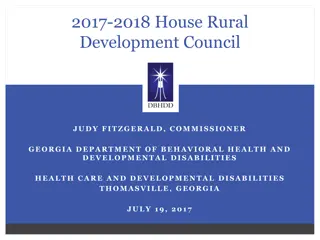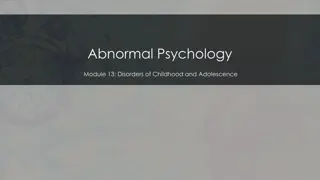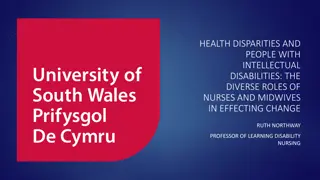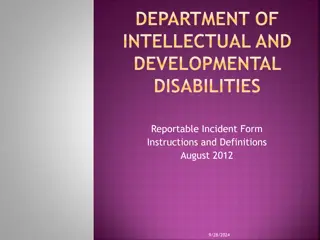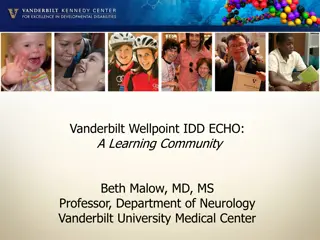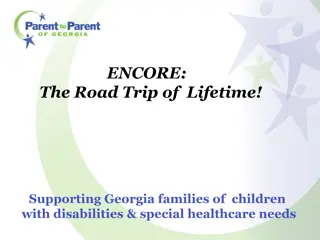Building a National Agenda for Supporting Families with Intellectual and Developmental Disabilities
This initiative aims to create a model framework for supporting families with a member who has intellectual or developmental disabilities across their lifespan. The project involves a community of practice focusing on various aspects such as family connections, employment, healthy living, housing support, information navigation, person-centered planning, behavior support, respite services, self-directed support, and technology. Through this program, stakeholders are encouraged to transition from fear-based responses to hope-based action planning, promoting family engagement, resilience, and community partnerships.
Download Presentation

Please find below an Image/Link to download the presentation.
The content on the website is provided AS IS for your information and personal use only. It may not be sold, licensed, or shared on other websites without obtaining consent from the author.If you encounter any issues during the download, it is possible that the publisher has removed the file from their server.
You are allowed to download the files provided on this website for personal or commercial use, subject to the condition that they are used lawfully. All files are the property of their respective owners.
The content on the website is provided AS IS for your information and personal use only. It may not be sold, licensed, or shared on other websites without obtaining consent from the author.
E N D
Presentation Transcript
Building a National Agenda for Supporting Families with a Member with Intellectual and Developmental Disabilities
Goal: To create a model framework for supporting families that addresses the needs of families with a family member with ID/DD across the lifespan. Wingspread Report http://www.ct.gov/dds/cwp/v iew.asp?a=2042&Q=537862 GRANT STATES* CONNECTICUT DISTRICT OF COLUMBIA *MISSOURI OKLAHOMA TENNESSEE WASHINGTON
Supporting Families Community of Practice http://supportstofamilies. org/cop/ 10 Committees Family-to-Family Connections Employment Healthy Living Housing/Home Supports Information Navigation Person-Centered Planning Positive Behavior Support Respite/Social Opportunities Self-Directed/In-Home Supports Technology
What Weve Learned Through the Supporting Families Community of Practice LEARNING BARRIERS What we hope will change System Change Learning takes time We are moving into a new generation of services. It is hard to let go of the familiar. Partnerships: Stakeholders move from fear-based responses to hope-based action planning
What Weve Learned Through the Supporting Families Community of Practice LEARNING BARRIERS What we hope will change Family Engagement Families benefit from collaborations with other families Isolated families result in increased needs over-time Funding for family networking, mentoring, training and care-giving supports are available to assist families to be resilient and to support new ideas
What Weve Learned Through the Supporting Families Community of Practice LEARNING BARRIERS What we hope will change Community Engagement & Reciprocal Contribution Stakeholders often ask for help from the community without showing how reciprocal contributions will occur. Training: Stakeholders learn the art & science of crossing thresholds and develop community partnerships based upon equality & mutual reward
What Weve Learned Through the Supporting Families Community of Practice LEARNING BARRIERS What we hope will change Life Course Principles Helping families build upon life stages is more effective then waiting for people to arrive at the door of adult services IDD services are not as effective or efficient as they can be when provided in a silo, or when services are separated from previous developmental stages Staffing: Partnering with practitioners from each life stage reduces duplication of services & helps lead to better outcomes for people with IDD. Appropriate support is available at each life stage.
What Weve Learned Through the Supporting Families Community of Practice Lifespan Areas of Change Accomplishments Future Next Steps Messaging Posters, Displays, DDS Family Website, Bookmark COP Website, Videos, Success Stories, DDS 101 updates Positions Youth Coordinator, Transition & Education Advisors, Case Managers, Family Resource Team Members Helpline, Case Managers, Employment and Technology Positions Partnerships DD Council, B3, SDE Lifespan Committee, SDE presentations, Transition Community of Practice, Aging Livable Communities Partnership, Assistive Technology Projects, Employment Partnerships Continued expansion with groups across the lifespan, especially local-based community groups Funding Respite, Family Grants *New providers, system improvements, new funding where possible Policies & Procedures PWCL Waiver Service *CoP Committees Sustainability Goals Training Academy Project Trainings for Families Quality LEAN, ADP/Compass Project- Navigating Across the Lifespan NCI, QSR
A GOOD LIFE Family, friends, neighbors, co- workers, community members, others Person- Centered Planning, Employment, Long Term Financial Planning Disability services, Medicaid, Social Security, DSS, Section 8 School, businesses, faith groups, other IPADS, Smart Phones, Home & Healthcare Aids, Remote Monitoring
What Weve Learned Through the Supporting Families Community of Practice LEARNING BARRIERS What we hope will change Caring For and Caring About Caring about people with ID/DD is the responsibility of all. It is not just a family concern. Separating caring about and caring for increases the probability of abuse & neglect Our communities become caring places for all. We care for ourselves and we care for one another.
As you look at the work of the committees consider: GOALS: What are the goals of this committee for the next two years? What are the planned activities of this committee? Can you -contribute to the implementation of these goals and activities? LEARNING MOMENTS: What did the committee learn in the first year? Did any of the learning moments provide ideas on how you can live your life/or do you work differently?
As you look at the work of the committees consider: BEST PRACTICES: What did the committee learn about best practices that they now want to share with others? How can you help share this information? POLICY CHANGES: What are the critical policy changes that this committee may have identified? Can you help with this?
Sharon Lewisis the Principal Deputy Administrator at the Administration for Community Living (ACL) From March 2010 to April 2012, Ms Lewis served as the Commissioner of the Administration on Developmental Disabilities. Prior to her appointment as Commissioner, she served as the Senior Disability Policy Advisor to U.S. House Committee on Education & Labor, advising members of the Committee on legislative strategy and disability-related policy issues in education, employment and healthcare, and as a Kennedy Public Policy Fellow for U.S. Senate Subcommittee on Children & Families. Sharon is the recipient of numerous awards, including the 2010 Distinguished Leadership in National Disability Policy Award and the Consortium for Citizens with Disabilities Chairman s Award. In Oregon, Sharon worked on public policy for the Oregon Developmental Disabilities Coalition and for The ARC. She served as co-chair of the Oregon Family Action Coalition Team, founded DisabilityCompass.org and managed the Oregon Partners in Policymaking Program. Sharon is a parent to three daughters, including one with a disability.
CT DDS NEW MODEL SERVICES Integrated Supports
Guiding Questions for Case Studies 1. How can you use the Life Course materials to help create a positive vision of the future for this family? What ideas do you have to help this family develop an integrated plan of supports? Building on Their Strengths and Assets Developing Relationship Based Supports Using Technology Creating Community- Based Supports Finding Eligibility- Based Supports What other unchartered possibilities may this family want to explore? Did the Life Course materials change the way you thought about how to provide supports for this family? In what ways? 2. 3. 4.
B3 Case Study - Matiu Matiu was born Deaf. At the time of his birth, his parents didn t know anyone who was Deaf and had few experiences being around people who had a disability. His parents, both of whom use Spanish as their primary language, knew that they needed to get more information, but were reluctant to talk to others about their son s disability. Matiu s parents also have concerns that he may be developmentally delayed and are unsure of where to get help. They hope that someday their son will be an accepted and valued part of their community.
Early Childhood (age 3-8) Case Study - Anne (Anne is a 4 year old who lives with her mother and father and big sister Jane in a typical suburban community.) One April morning, after eight months of assessment, observations and countless appointments we were told that our physically perfect, attractive four-year-old daughter was handicapped ; she was diagnosed as having autism. The grief was almost all consuming and our lives changed forever. Our daughter s inability to understand people and language causes her constant stress. She copes by organizing her life into structured routines that only she understands. Just coping is difficult for our family and for her. This has been compounded by the difficulties of the system and an unaccepting community. All we hope for is that our daughter will be an accepted, valued member of our community who has the opportunity to contribute and participate.
Middle School Case Study Kevin Kevin is a 14 year old young man with significant intellectual disabilities who is attending his neighborhood middle school. He receives daily instruction in Literacy (reading, writing, and communication), Math, and Science. Kevin also is involved in vocational and daily living skill training. His coursework is delivered in individual and small group settings in the special education classroom except for Digital Communications (a general education Career Technical Course) which he has taken (using a modified curriculum) with the assistance of a one-on-one instructional assistant. Kevin also participates in a school-based enterprise through the Occupational Course of Study (a state endorsed curriculum for students with special needs leading to a high school diploma) and an on-campus work placement in the school library. Kevin and his family plan for him to stay in the public schools until he ages out at age 21. Kevin lives at home with mother, step-father, 11 year old sister, and a great aunt that helps with his care. Kevin also has one older brother who is in college.
High School Case Study Paul Paul is a sixteen year African American male who has an intellectual disability and who experiences mood swings and hears voices that other people don t understand. Paul s family lives in a small town, where gossip spreads like wildfire. He often stays home alone playing video games and has little confidence about his future. Paul really wants to work. He would like to start his own business someday. Paul lives with his mother and with his younger sister, who has a learning disability. His family is very involved in their church and they get a lot of natural support from this community.
Adult Case Study Janie Jane is 23 years old and has Down Syndrome. She attended public high school, where she met her live-in boyfriend Sam. She lives in a large metropolitan area in a neighborhood that used to be considered respectable. However, recently there has been a lot of crime reported in the neighborhood. Jane s Voice: After having my baby and returning to the ward, people reacted to me really differently. Some people were very supportive. Others assumed that I was just a visitor from another ward or were amazed that I had actually been able to have my own baby. Some mothers I talked to even overheard comments like, I think it s disgusting, letting them have babies. The nurse told me they have to give me a test to see if I can keep my baby. I want to bring my baby home and take care of her. I know I will need some help, but I am going to try and be the best mom I can be.
Aging Case Study Margaret Margaret is 60 years old. She lives in a group home with four other people who are younger than her. She has lived in the home for the last twenty years. She wants to remain in the home with people who know and care about her. She has very little contact with her family and no friends outside of the people with whom she lives. Four months ago Margaret fell and was knocked out. From that day onward she has been a different person. She is often disoriented and has difficulty caring for herself. She is often in pain so is not in the best of moods. Her health is declining and the agency is not sure what to do next.




